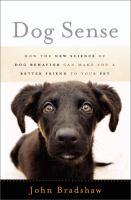
 In one of my usual somewhat harebrained moments I adopted Newman, a beautiful mini Australian Shepherd, from a dog rescue group in Stanley, KS. Within 24 hours, I realized that I had a severely neurotic dog on my hands. Although my mother-in-law insists he is psychotic, I don’t think he would try to kill us in our beds—he’s more worried we will try to kill him in his. But I digress—in my attempt to understand how and why Newman does anything, I ran across Dog Sense which reinforces some of the “training” I have attempted with him. Bradshaw reinforces all of his statements will solid science, and begins with tracing the dog’s ancestry from wolves. But he is quick to say that the Canidae line, which shares 99.96% of its DNA with gray wolves, was arrested somewhere during development and was therefore suited to domestication. In examining the social lives of wolves and comparing them to the social lives of dogs, he dismisses the idea that there is a need for a “‘dominance’ structure based on self-interest and aggression”. In fact, trying to dominate a dog usually results in just frightening him and leads to great confusion in any dog. He advocates training based on positive reinforcement, utilizing the behavior of dogs that naturally occurs and working from that platform. This is a fascinating and highly scientific examination of dog behaviors, and because of its scientific base, it can be chore to get through the first 3 or 4 chapters specifically. The subsequent chapters are much easier to digest, and I actually managed to read the whole thing in a few days, with one eye on my neurotic dog. He has come a long way, with lots of treats and lots of love, and is a playful, happy, mostly obedient dog, although still highly wary of men, children, umbrellas, plastic bags, thunder, trash cans, and dropped spoons.
In one of my usual somewhat harebrained moments I adopted Newman, a beautiful mini Australian Shepherd, from a dog rescue group in Stanley, KS. Within 24 hours, I realized that I had a severely neurotic dog on my hands. Although my mother-in-law insists he is psychotic, I don’t think he would try to kill us in our beds—he’s more worried we will try to kill him in his. But I digress—in my attempt to understand how and why Newman does anything, I ran across Dog Sense which reinforces some of the “training” I have attempted with him. Bradshaw reinforces all of his statements will solid science, and begins with tracing the dog’s ancestry from wolves. But he is quick to say that the Canidae line, which shares 99.96% of its DNA with gray wolves, was arrested somewhere during development and was therefore suited to domestication. In examining the social lives of wolves and comparing them to the social lives of dogs, he dismisses the idea that there is a need for a “‘dominance’ structure based on self-interest and aggression”. In fact, trying to dominate a dog usually results in just frightening him and leads to great confusion in any dog. He advocates training based on positive reinforcement, utilizing the behavior of dogs that naturally occurs and working from that platform. This is a fascinating and highly scientific examination of dog behaviors, and because of its scientific base, it can be chore to get through the first 3 or 4 chapters specifically. The subsequent chapters are much easier to digest, and I actually managed to read the whole thing in a few days, with one eye on my neurotic dog. He has come a long way, with lots of treats and lots of love, and is a playful, happy, mostly obedient dog, although still highly wary of men, children, umbrellas, plastic bags, thunder, trash cans, and dropped spoons.
